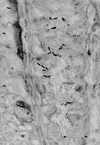Helicobacter cetorum sp. nov., a urease-positive Helicobacter species isolated from dolphins and whales
- PMID: 12454148
- PMCID: PMC154630
- DOI: 10.1128/JCM.40.12.4536-4543.2002
Helicobacter cetorum sp. nov., a urease-positive Helicobacter species isolated from dolphins and whales
Abstract
A novel helicobacter with the proposed name Helicobacter cetorum, sp. nov. (type strain MIT 99-5656; GenBank accession number AF 292378), was cultured from the main stomach of two wild, stranded Atlantic white-sided dolphins (Lagenorhynchus acutus) and from the feces of three captive cetaceans (a Pacific white-sided dolphin [Lagenorhynchus obliquidens]; an Atlantic bottlenose dolphin [Tursiops truncatus]; and a beluga whale [Delphinapterus leucas]). The infected captive cetaceans were either subclinical, or clinical signs included intermittent regurgitation, inappetance, weight loss, and lethargy. Ulcers were observed in the esophagus and forestomach during endoscopic examination in two of the three captive animals. In the third animal, esophageal linear erosions were visualized endoscopically, and histopathological evaluation of the main stomach revealed multifocal lymphoplasmacytic gastritis with silver-stained spiral-shaped bacteria. Helicobacter cetorum is a fusiform gram-negative bacterium with a single bipolar flagellum. The isolates grow under microaerobic conditions at 37 and 42 degrees C but not at 25 degrees C. H. cetorum is urease, catalase, and oxidase positive, and it is sensitive to cephalothin. The isolates from the wild, stranded dolphins were sensitive to nalidixic acid, whereas the isolates from the collection animals were resistant. By 16S rRNA sequencing it was determined that H. cetorum represented a distinct taxon that clusters most closely with H. pylori. Further studies are necessary to determine the role of H. cetorum in the development of gastric ulcers and gastritis of cetaceans. This is the first description and formal naming of a novel Helicobacter species from a marine mammal.
Figures






References
-
- Banatvala, N., C. Romero Lopez, and R. J. Owen. 1994. Use of the polymerase chain reaction to detect Helicobacter pylori in the dental plaque of healthy and symptomatic individuals. Microb. Ecol. Health. Dis. 7:1-8.
-
- Barbosa, A., J. Silva, A. Nogueira, E. Paulino, and C. Miranda. 1995. Higher incidence of Gastrospirillum sp. in swine with gastric ulcer of the pars oesophagea. Vet. Pathol. 32:134-139. - PubMed
-
- Batchelder, M., J. G. Fox, A. Hayward. 1996. Natural and experimental Helicobacter mustelae reinfection following successful antimicrobial eradication in ferrets. Helicobacter 1:34-42. - PubMed
-
- Bury-Mone, S., S. Skouloubris, A. Labigne, and H. De Reuse. 2001. UreI: a Helicobacter pylori protein essential for resistance to acidity and for the early steps of murine gastric mucosa infection. Gastroenterol. Clin. Biol. 25:659-663. - PubMed
-
- Cavallini, A., M. Notarnicola, P. Berloco, A. Lippolis, and A. De Leo. 2000. Use of macroporous polypropylene filter to allow identification of bacteria by PCR in human fecal samples. J. Microbiol. Methods 39:265-270. - PubMed
Publication types
MeSH terms
Substances
Associated data
- Actions
Grants and funding
LinkOut - more resources
Full Text Sources
Medical
Molecular Biology Databases

